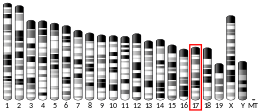40S ribosomal protein S10
40S ribosomal protein S10 is a protein that in humans is encoded by the RPS10 gene.[5][6][7]
Function
Ribosomes, the organelles that catalyze protein synthesis, consist of a small 40S subunit and a large 60S subunit. Together these subunits are composed of 4 RNA species and approximately 80 structurally distinct proteins. This gene encodes a ribosomal protein that is a component of the 40S subunit. The protein belongs to the S10E family of ribosomal proteins. It is located in the cytoplasm. As is typical for genes encoding ribosomal proteins, there are multiple processed pseudogenes of this gene dispersed through the genome.[7]
Clinical significance
Variable expression of this gene in colorectal cancers compared to adjacent normal tissues has been observed, although no correlation between the level of expression and the severity of the disease has been found.[7] Mutations in the RPS10 gene can cause Diamond–Blackfan anemia, a congenital anemia sometimes associated with bone marrow failure.[8]
Interactions
RPS10 has been shown to interact with PTTG1.[9]
References
- GRCh38: Ensembl release 89: ENSG00000124614 - Ensembl, May 2017
- GRCm38: Ensembl release 89: ENSMUSG00000052146 - Ensembl, May 2017
- "Human PubMed Reference:". National Center for Biotechnology Information, U.S. National Library of Medicine.
- "Mouse PubMed Reference:". National Center for Biotechnology Information, U.S. National Library of Medicine.
- Frigerio JM, Dagorn JC, Iovanna JL (Jul 1995). "Cloning, sequencing and expression of the L5, L21, L27a, L28, S5, S9, S10 and S29 human ribosomal protein mRNAs". Biochim Biophys Acta. 1262 (1): 64–8. doi:10.1016/0167-4781(95)00045-i. PMID 7772601.
- Kenmochi N, Kawaguchi T, Rozen S, Davis E, Goodman N, Hudson TJ, Tanaka T, Page DC (Aug 1998). "A map of 75 human ribosomal protein genes". Genome Res. 8 (5): 509–23. doi:10.1101/gr.8.5.509. PMID 9582194.
- "Entrez Gene: RPS10 ribosomal protein S10".
- Doherty, L; Sheen, MR; Vlachos, A; Choesmel, V; O'Donohue, MF; Clinton, C; Schneider, HE; Sieff, CA; Newburger, PE; Ball, SE; Niewiadomska, E; Matysiak, M; Glader, B; Arceci, RJ; Farrar, JE; Atsidaftos, E; Lipton, JM; Gleizes, PE; Gazda (Feb 2010). "Ribosomal protein genes RPS10 and RPS26 are commonly mutated in Diamond–Blackfan anemia. HT". Am J Hum Genet. 86 (2): 222–8. doi:10.1016/j.ajhg.2009.12.015. PMC 2820177. PMID 20116044.
- Pei, L (Jan 1999). "Pituitary tumor-transforming gene protein associates with ribosomal protein S10 and a novel human homologue of DnaJ in testicular cells". J. Biol. Chem. 274 (5): 3151–8. doi:10.1074/jbc.274.5.3151. ISSN 0021-9258. PMID 9915854.
Further reading
- Wool IG, Chan YL, Glück A (1996). "Structure and evolution of mammalian ribosomal proteins". Biochem. Cell Biol. 73 (11–12): 933–47. doi:10.1139/o95-101. PMID 8722009.
- Vladimirov SN, Ivanov AV, Karpova GG, et al. (1996). "Characterization of the human small-ribosomal-subunit proteins by N-terminal and internal sequencing, and mass spectrometry". Eur. J. Biochem. 239 (1): 144–9. doi:10.1111/j.1432-1033.1996.0144u.x. PMID 8706699.
- Pei L (1999). "Pituitary tumor-transforming gene protein associates with ribosomal protein S10 and a novel human homologue of DnaJ in testicular cells". J. Biol. Chem. 274 (5): 3151–8. doi:10.1074/jbc.274.5.3151. PMID 9915854.
- Malygin AA, Shaulo DD, Karpova GG (2001). "Proteins S7, S10, S16 and S19 of the human 40S ribosomal subunit are most resistant to dissociation by salt". Biochim. Biophys. Acta. 1494 (3): 213–6. doi:10.1016/s0167-4781(00)00252-9. PMID 11121577.
- Bortoluzzi S, d'Alessi F, Romualdi C, Danieli GA (2002). "Differential expression of genes coding for ribosomal proteins in different human tissues". Bioinformatics. 17 (12): 1152–7. doi:10.1093/bioinformatics/17.12.1152. PMID 11751223.
- Strausberg RL, Feingold EA, Grouse LH, et al. (2003). "Generation and initial analysis of more than 15,000 full-length human and mouse cDNA sequences". Proc. Natl. Acad. Sci. U.S.A. 99 (26): 16899–903. Bibcode:2002PNAS...9916899M. doi:10.1073/pnas.242603899. PMC 139241. PMID 12477932.
- Malygin A, Baranovskaya O, Ivanov A, Karpova G (2003). "Expression and purification of human ribosomal proteins S3, S5, S10, S19, and S26". Protein Expr. Purif. 28 (1): 57–62. doi:10.1016/S1046-5928(02)00652-6. PMID 12651107.
- Ballif BA, Villén J, Beausoleil SA, et al. (2005). "Phosphoproteomic analysis of the developing mouse brain". Mol. Cell. Proteomics. 3 (11): 1093–101. doi:10.1074/mcp.M400085-MCP200. PMID 15345747.
- Gerhard DS, Wagner L, Feingold EA, et al. (2004). "The Status, Quality, and Expansion of the NIH Full-Length cDNA Project: The Mammalian Gene Collection (MGC)". Genome Res. 14 (10B): 2121–7. doi:10.1101/gr.2596504. PMC 528928. PMID 15489334.
- Rush J, Moritz A, Lee KA, et al. (2005). "Immunoaffinity profiling of tyrosine phosphorylation in cancer cells". Nat. Biotechnol. 23 (1): 94–101. doi:10.1038/nbt1046. PMID 15592455.
- Andersen JS, Lam YW, Leung AK, et al. (2005). "Nucleolar proteome dynamics". Nature. 433 (7021): 77–83. Bibcode:2005Natur.433...77A. doi:10.1038/nature03207. PMID 15635413.
- Yu Y, Ji H, Doudna JA, Leary JA (2005). "Mass spectrometric analysis of the human 40S ribosomal subunit: Native and HCV IRES-bound complexes". Protein Sci. 14 (6): 1438–46. doi:10.1110/ps.041293005. PMC 2253395. PMID 15883184.
- Stelzl U, Worm U, Lalowski M, et al. (2005). "A human protein-protein interaction network: a resource for annotating the proteome". Cell. 122 (6): 957–68. doi:10.1016/j.cell.2005.08.029. PMID 16169070.
- Ewing RM, Chu P, Elisma F, et al. (2007). "Large-scale mapping of human protein–protein interactions by mass spectrometry". Mol. Syst. Biol. 3 (1): 89. doi:10.1038/msb4100134. PMC 1847948. PMID 17353931.
External links



